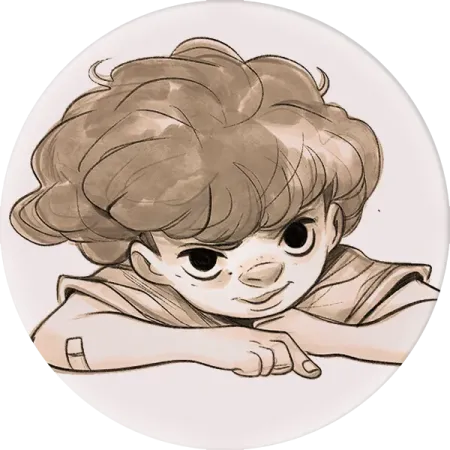The river
in the box
Where it all begins…
And in a wooden box, it turns out
a whole miniature world
could quietly fit.
Firecurl was just wondering whether to keep sulking or, on the contrary, admit her guilt, when the doorbell rang. At least for the moment, it felt like a welcome distraction, and she dashed down the stairs. In the chaos, maybe she’d come up with something better than a miserable apology.
But downstairs, a surprise awaited her — one that made her forget all about the incident with the doll. Standing at the door was a tall, elderly gentleman. He looked so unusual that Anne even felt a little scared at first. He wore a coat that reached almost to the ground (she broke into a sweat just imagining how hot it must be to wear such a thing in the middle of summer). On his head sat a tall top hat, decorated with shiny golden stars. His gaunt, high-cheekboned face — framed by a long beard that reached his chest — might have looked a bit frightening, if it weren’t for his eyes: playful and cheerful, even beneath the heavy awnings of the thickest eyebrows Anne had ever seen.
“Good evening,” the gentleman said. His voice sounded surprisingly youthful. “My name is Nehrod Laptsev, and I trade in toys. May I come in for a moment?”
Anne was so stunned that before she realized what was happening, she was already leading the gentleman up the wooden staircase. The old, battered wheeled suitcase he dragged behind him squeaked plaintively on every step.
“Mom, Mom! This gentleman... uhhh...” — Anne turned to the old man for help.
“Laptsev. Nehrod Laptsev,” he prompted.
“Mr. Laptsev trades in toys. His whole giant suitcase is full of toys!” — Completely forgetting about the doll, Anne was already dreaming of the fantastic surprises hidden in the old suitcase.
Reflections on the scene
⸻ ❦ ⸻
– ❦ –
This is not just an introduction. It’s a rite of passage. The story opens not with wonder, but with rupture: a tantrum, a shattered toy, a disappointed parent. The doll is mutilated, the mother turns away, and the child—Anne—is left alone with her rage and shame.
This moment plants the book’s first essential question:
What does it mean to destroy what you love?
And deeper still:
Where does that impulse come from?
Enter Mr. Laptsev, mysterious but oddly transactional. He offers not comfort, but a product: a magical game that seems too strange to trust. It’s bigger on the inside, filled with impossible landscapes and moving pieces. But above all—it is alive. The Forest breathes, listens, and, as Anne will learn, remembers.
When Anne lashes out and smashes the game with a hammer, it is not out of malice. It is something far more complex: a child testing the limits of consequence. And this time, the consequence stares back. The game doesn’t simply break—it reacts. It answers. And with that, a line is crossed.
This is the true beginning of the journey—not a leap into fantasy, but a moral awakening. Anne does not escape into the Forest. She is summoned—by her own actions, by guilt, and by the strange magic of responsibility.
There’s no prophecy here. No chosen one. Just a girl who makes a mistake—and is asked to face it.






